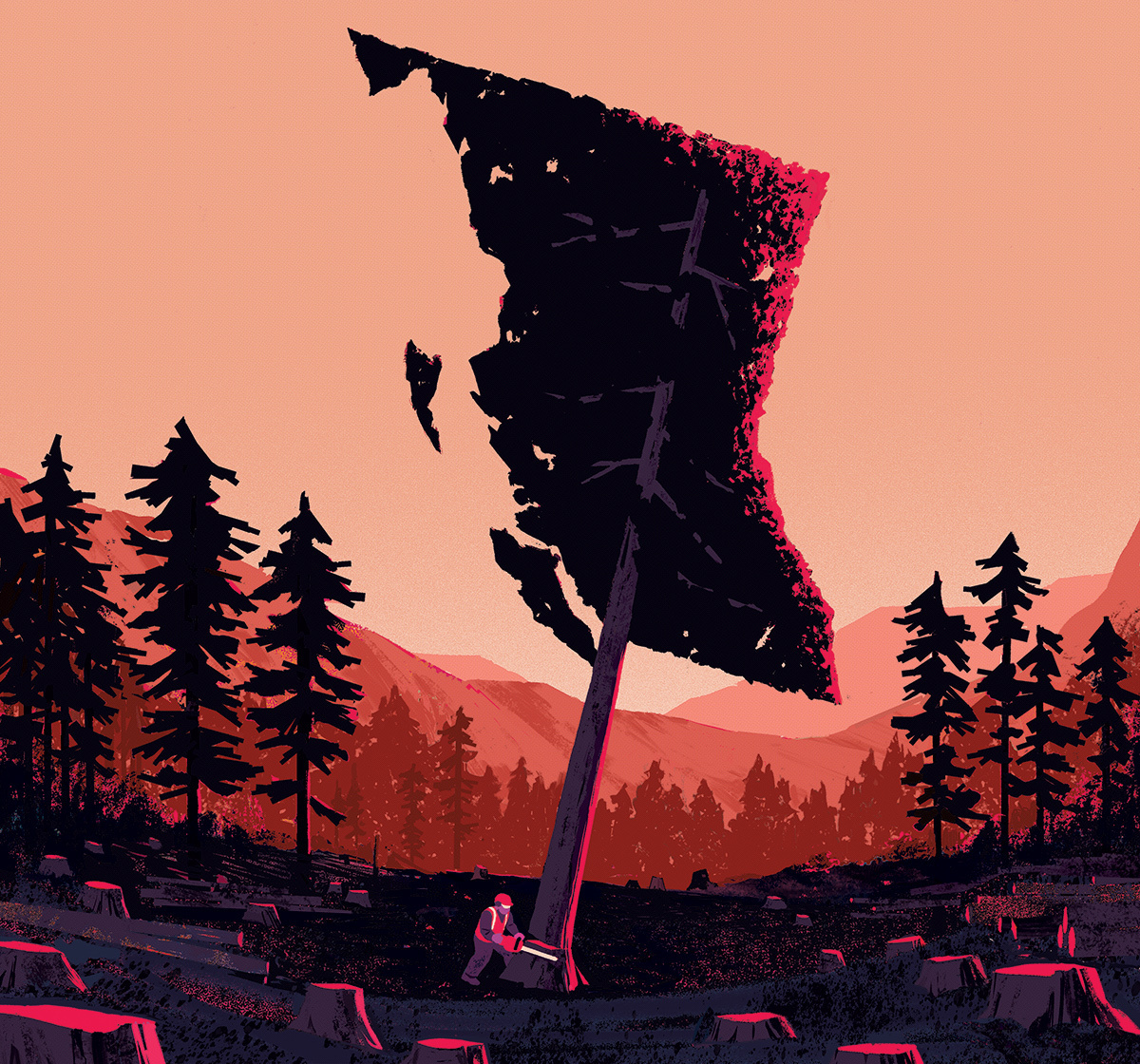In 2019, British Columbia’s logging industry generated $13 billion for the province, according to the BC Council of Forest Industries. In 2020, however, timber companies responded to COVID-19 uncertainty by cutting production. It turned out to be an overcorrection. Home renovations and new construction both quickly increased, and mills struggled to catch up to the demand. The price of lumber per board foot skyrocketed 254 percent from pre-pandemic levels. Stumpage fees—the price timber companies pay the provincial government to harvest trees on Crown land—followed suit, hitting $94.54 per cubic metre in 2021, triple the price of the previous spring. While demand is exceptionally high, so is the cost of doing business in the province.
This cost is exacerbated by a storm of threats closing in from every direction, a worse state of affairs for logging than at any time in the provincial industry’s history. In the interior of BC, the mountain pine beetle continues to kill millions of hectares of forest by burrowing into needle-bearing evergreens and turning them a foreboding shade of red. The past five years have seen three of the province’s worst fire seasons in recorded history. On the ground, the view is dire too, made evident by the anti-old-growth-logging blockades and arrests around the Fairy Creek watershed, on Vancouver Island. Last November, the province finally announced its intent to defer the logging of 2.6 million hectares of some of the most at-risk old growth for about two years. The announcement was met with a scramble among some of the 204 consulted First Nations, who stated that they needed more time to decide how best to manage their territories, along with outcries from the logging sector about lost employment.
Through the spring and summer of 2021, facing ecological, financial, and political complications, some of BC’s largest lumber producers—Canfor, West Fraser, Interfor, Tolko, and Teal Jones—announced the expansion or establishment of sawmills not at home but in the southern United States, to process the yellow pine that grows quickly in the warmer climes of Texas and Louisiana. So far, these out-of-province investments total approximately $6 billion, a major expansion of operations that leaves the future of BC’s timber industry even more uncertain. The province’s companies have decided that this perfect storm is not one they care to weather or remediate. Instead, they are turning away from spearheading a sustainable logging industry in the province, toward calmer and greener pastures abroad.
Only 12 percent of Canada’s forests are considered hardwood, mostly deciduous trees that produce lumber prized for finishes and furniture. The majority, approximately two-thirds, is softwood, from less-dense conifers that grow at a faster rate. This wood has a wide variety of uses, from fence posts to the dimensional lumber used to frame houses. Canada is one of the largest exporters of softwood in the world, alongside Russia, with 54 percent of its exports coming from BC alone. Almost half of the province’s softwood exports are sold to the US.
The US government has long claimed that Canada unfairly subsidizes its own industry: most timber land in Canada is owned by the government, which means it can produce lumber at a lower cost to companies. In the US, most of the forest land is privately owned, meaning companies are required to pay market rates. To make up for the glut of cheaper Canadian lumber, the US has engaged Canada in a tariff-slapping battle that dates back to 1982, one of the longest trade disputes between the two countries. A deal struck in 2006 expired in 2015, which led to the return of costly litigation and, last November, a doubling of tariffs on Canadian softwood—increasing prices for American consumers.
For Canadian companies, the allure of privately owned US stands of fast-growing yellow pine includes the fact that there is lower—or no—tariffs. Louisiana is currently half forested and looking to become less so by investing in logging. To seal Canfor’s $160 million (US) investment in a new sawmill, the state offered the company an incentive package including the possibility of using Louisiana’s Industrial Tax Exemption Program, which provides manufacturers in the state an 80 percent property-tax reduction for up to ten years. Incentives aside, the biggest company in BC lumber, among others, pivoting away from one geographically sensitive zone to another similarly vulnerable one raises questions about foresight. Instability exists there too: in 2020, Hurricane Laura caused $1.1 billion (US) in losses for the state’s timber industry, and wildfires in Louisiana are predicted to nearly double by 2050. (Canfor, Tolko, Interfor, West Fraser, and Teal Jones—all of which have bought sawmills or are building new ones in the southern US—declined or did not respond to interview requests.)
The move also raises questions about effect. Susan Yurkovich, president of the BC Council of Forest Industries, which represents a majority of lumber, pulp-and-paper, and manufactured-wood producers in the province, claims the move south is an attempt to offer Canadian and international customers as much variety as possible. And, she says, it’s about growing in step with market demands as well as securing the long-term viability of the industry. “You want to make sure that you’re going to have access to that fibre for a length of time so that you can make that big investment and employ those people and put a facility in a community.” While Yurkovich notes that the surge of recent activism concerning BC old-growth protection has not been a factor in the timber companies’ expansion abroad, the resultant deferrals have meant less high-value forest available for logging and more contentious circumstances on the ground.
While the American pivot might seem to spell victory for BC conservationists—it appears to mean fewer trees being cut down in Canada—the view up close is more sobering. “Moving the equipment down to the southern US and keeping their whole value-added operation down there, they’re not going to stop cutting down trees here,” says Torrance Coste, the national campaign director at the not-for-profit watchdog Wilderness Committee. Before the late 1990s, he says, the number of jobs was in proportion to the fluctuating amount of forest cut, but that balanced relationship has been decoupled. More raw logs are exported to hungry markets in China and the US, to be transformed into marketable timber there. This has meant the closure of many BC sawmills and fewer local jobs per tree cut.
Wilderness Committee, Coste notes, is calling not for an end to BC’s timber industry but for diversified use of the land. Jobs are part of the equation. Using forests in ways other than logging, including investing in tourism or wild-food companies, helps communities be more resilient—especially after timber companies, whose mills fuel municipal taxes, depart when there’s nothing left to log. Wilderness Committee wants to avoid fates like that of Youbou, in Vancouver Island’s Cowichan Valley, which was a logging town for decades until its mill closed and local benefits evaporated. The provincial government has plans to help workers through the transition by offering retraining and, for those fifty-five and up, a $75,000 retirement incentive. (Since its creation, in 2019, during a downturn in the industry, the retirement program has been used by over 1,000 workers, with a total of $46 million in benefits distributed.)
Timber jobs have been disappearing since long before stumpage-fee and US-tariff increases, policy shifts, protests, and logging deferrals. Since 2005, thirty-five BC mills have closed, often leaving behind husks of communities. “In a land base as vast as Canada, the strategy is to log it really fast, to put a lot of products on the market right away,” Coste says. “That policy is really bad for ecosystems, but it’s also really bad for local jobs.”
Katrine Conroy, the provincial minister of forests, lands, natural resource operations, and rural development, once worked at a pulp mill, and her granddaughter recently became the fourth generation in her family to work at that same mill. “I want to make sure that, if any one of [my] grandkids works in the forest industry like I did when I was younger, they’ll have the opportunity to do that,” she says, “but also they’ll have the opportunity to walk in a forest, they’ll be able to see the wildlife, they’ll be able to see the old-growth trees.” She points to smaller timber companies, which don’t have capital to invest abroad, that are shifting -toward products that use every part of the tree, such as veneer and lignin, a natural glue that can be added as a binder to materials such as asphalt. Within the minister’s Kootenay West district, the Kalesnikoff sawmill, for example, has expanded its operations to include the production of mass timber, or engineered wood, which both keeps processing jobs within the province and doesn’t rely on harvesting old-growth trees. But Conroy has concerns about the investment shifts of the province’s larger timber companies. “We want people to invest in BC,” she says.
In its February budget, the BC government predicted a 10 percent decline in revenue from logging in the next two years: stumpage fees paid to the province are expected to decrease, and vertiginous prices for products like dimensional lumber and paper are predicted to stabilize. The amount of trees BC timber companies are allowed to cut in a year is also predicted to decrease, from 45 million cubic metres in 2021 to 38.5 million cubic metres by 2023—all of which may only incentivize more investment abroad.
What defines timber jobs in 2022 is very different from our lumberjack stereotypes. Approximately 50,000 British Columbians work in timber, which includes forest managers, engineers, biologists, log buyers, truck drivers, and tree planters. The industry isn’t made up only of people felling trees or operating mills, so moves from big industry players have broad outcomes. Earlier this year, the BC Investment Management Corporation invested government pension funds in a 772,000-acre tract of forested land in eastern Texas, betting on its future value. This is the first of many unpredictable ripple effects to come.
What is clear is that the expansion into the US is another step away from developing a sustainable logging industry in BC, the result of treating local jobs as less important than the profits of a few. The move may end up being one very large tree falling in an increasingly sparse forest.




